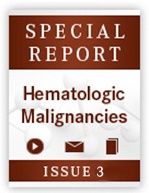Management of ET, PV Requires 2 Distinct Approaches
Distinguishing between polycythemia vera (PV) and essential thrombocythemia (ET) is key for the effective treatment of both diseases, said Heinz Gisslinger, MD, of the Medical University of Vienna.
Heinz Gisslinger, MD
Distinguishing between polycythemia vera (PV) and essential thrombocythemia (ET) is key for the effective treatment of both diseases, said Heinz Gisslinger, MD, of the Medical University of Vienna.
“We need to have an exact diagnosis in ET because we have more compounds in this disorder so it has to be separated from PV,” said Gisslinger, who presented on the topic at the 2016 Society of Hematologic Oncology annual meeting. “Treatment is also different in PV versus ET. ET patients diagnosed according to World Health Organization (WHO) criteria have superior survival in comparison to PV.”
ET is frequency misdiagnosed as PV and overtreated, particularly with hydroxyurea, according to Gisslinger.
Past studies have shown that hydroxyurea with aspirin is superior to the combination of anagrelide and aspirin for the initial management of ET. However, these studies used classification criteria from the Polycythemia Vera Study Group (PVSG) and not more updated WHO classification criteria, said Gisslinger.
“Hydroxyurea is certainly superior in those patients where we have a mixed population of PV and ET,” said Gisslinger. “But if we have just a pure population of ET according to WHO classification, anagrelide is just as good as hydroxyurea. Therefore, the clear-cut diagnosed ET patients are sometimes overtreated with hydroxyurea.”
Managing ET
When it comes to the management of PV and ET, different considerations must also be made. In ET, the primary objective of treatment is to prevent thromboembolic complications. Because of this, it is very important to clearly define risk status for patients, said Gisslinger.
The revised International Prognostic Score of thrombosis in WHO-Essential Thrombocythemia (IPSET-thrombosis) defines very low risk as patients less than 60 years old, withJAK2-negative disease, and no prior thrombocythemia; low-risk patients as those less than 60, withJAK2+ disease, and no prior thrombocythemia; intermediate-risk patients as those older than 60, withJAK2- disease, and no prior thrombocythemia; and high-risk patients as anyone withJAK2- disease and prior thrombocythemia, and those over 60 withJAK2+ disease, and no prior thrombocythemia.1
Properly identifying risk of thromboembolic complications in ET is essential when making treatment decisions, especially regarding the use of low-dose aspirin, said Gisslinger.
A 2016 study published inHaematologicaassessed the benefits and risk of low-dose aspirin in 433 patients with low-risk ET, 271 who had a calreticulin (CALR) mutation and 162 with aJAK2mutation.2
The study found that inCALR-mutated patients, antiplatelet therapy did not affect the risk of thrombosis but was associated with a higher incidence of bleeding (12.9 versus 1.8 episodes per 1000 patient-years,P= 0.03). InJAK2-mutated patients, low-dose aspirin was associated with a reduced incidence of venous thrombosis with no effect on the risk of bleeding.
“In the low-risk population it is important to differentiate betweenJAK2- andJAK2+,” said Gisslinger. “Most of these patients areCALR-positive. InCALR+ patients in the low-risk cause, aspirin is probably an overtreatment because in that caseCALR-positivity patients suffer more risk of bleeding during aspirin. You should avoid aspirin inCALR+ low-risk ET patients.”
Managing PV
In PV, several new agents have recently made a difference in the management of the disease.
This includes ruxolitinib (Jakafi), a JAK1 and JAK2 inhibitor which has shown promise in PV, said Gisslinger.
A phase III study published in theNew England Journal of Medicineinvestigated ruxolitinib versus standard therapy in patients with PV who had an inadequate response to or had unacceptable side effects from hydroxyurea.3
The primary end point was the proportion of patients who had both hematocrit control and a reduction of 35% or more in spleen volume from baseline at week 32, as assessed by means of centrally reviewed MRI or CT studies. The primary endpoint was achieved in 21% of the patients in the ruxolitinib group versus 1% of those in the standard-therapy group (P<0.001). Hematocrit control was achieved in 60% of patients receiving ruxolitinib and 20% of those receiving standard therapy; 38% and 1% of patients in the 2 groups, respectively, had at least a 35% reduction in spleen volume. A complete hematologic remission was achieved in 24% of patients in the ruxolitinib group and 9% of those in the standard-therapy group (P= 0.003).
Based on these and other findings, the Central European Myeloproliferative Neoplasms Organization (CEMPO) treatment guidelines for PV currently suggest that patients with low-risk PV receive low-dose aspirin plus phlebotomy in the first-line setting and pegylated interferon alpha (PEG-IFN-α) in the second-line setting. High-risk patients with PV less than 70 with no major comorbidities should receive PEG-IFN-α in the first-line setting and hydroxyurea or a JAK2 inhibitor in the second-line setting. Patients older than 70 or with comorbidities should receive PEG-IFN-α or hydroxyurea in the first-line setting and a JAK2 inhibitor in the second-line setting.
“In those patients that are hydroxyurea intolerant or resistant, ruxolitinib has shown to work excellently, causing not so frequent complete hematologic remissions, but improving dramatically the clinical symptoms like spleen size, and also the rate of thrombotic complications,” said Gisslinger. “Ruxolitinib is certainly a very attractive compound in this space. Taking these new compounds together we have a new set of guidelines for the management of PV.”
References:
- Barbui T, Thiele J, Vannucchi AM, et al. Rationale for revision and proposed changes of the WHO diagnostic criteria for polycythemia vera, essential thrombocythemia and primary myelofibrosis. [Published online 14 August 2015]Blood Cancer J.2015;5,e337.
- Alvarez-Larrán A, Pereira A, Guglielmelli P, et al. Antiplatelet therapy versus observation in low-risk essential thrombocythemia with a CALR mutation” [Published online May 12, 2016]Haematologica.2016;101(8):926-931.
- Vannucchi AM, Kiladjian JJ, Griesshammer Martin, et al. Ruxolitinib versus Standard Therapy for the Treatment of Polycythemia Vera.N Engl J Med.2015;372:426-435.

Survivorship Care Promotes Evidence-Based Approaches for Quality of Life and Beyond
March 21st 2025Frank J. Penedo, PhD, explains the challenges of survivorship care for patients with cancer and how he implements programs to support patients’ emotional, physical, and practical needs.
Read More